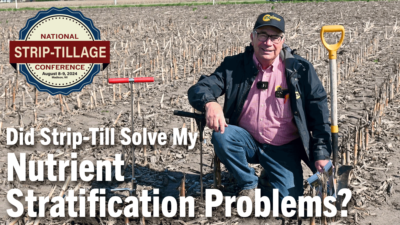While strip-tillers are always looking to add a few more bushels per acre, it’s worth noting that increasing yields isn’t always the primary objective for adopting the practice.
As most farmers will attest, the benefits of strip-till are multilayered. The diversity of value allows strip-tillers to prioritize one or more of these benefits within their overall system.
In our latest online poll, we asked strip-tillers to identify their primary objective with the practice heading into 2016. The results have thus far been pretty clear: Nearly 80% of respondents say improving soil health is their top priority in 2016, with another 14% looking to cut fertilizer and seed costs. In third place is boosting yields, with only 7% saying that’s their top goal this year.

Perhaps it’s not surprising that the vast majority of strip-tillers are emphasizing soil health because they likely understand that increasing organic matter and utilizing cover crops to retain nutrients and moisture will maintain or increase yield.
This is true of Lakefield, Minn., farmers Jerry and Nancy Ackermann, who began strip-tilling 15 years ago on their 1,200-acre operation. While they set and often exceed annual yield goals with their strip-tilled corn, the Ackermanns also see their success as a product of their trial and error, and getting the most out of their variable soils, which range from heavy Webster clay and loam to light, sandy soil.
They have a goal of raising 200-bushel corn on 140 pounds of nitrogen (N), and at 190-bushel yields they’re pretty close to achieving it. They typically out-yield the county average by 20 bushels for corn, while lowering fertilizer inputs through calculated experimentation and a constant desire for improvement.
This includes a move away from anhydrous ammonia application to urea through a controlled-release product with an N stabilizer and a reduction in N application in the strip from 100 pounds per acre to 40.
The Ackermanns were one of three farmers recognized at this year’s National No-Tillage Conference for their innovative fertilization practices and commitment to long-term sustainability.
“Field length strips encompass different soils and different hills and valleys,” Jerry says. “Monitoring the changes in methods gives us a chance to see what works best. When we see a major increase in production from one year to the next, it doesn’t take a rocket scientist to figure out something’s working.”
Visit www.StripTillFarmer.com and take our current poll to share your top strip-till priority in 2016 or contact me at (262) 777-2441, or send me an email at jzemlicka@lessitermedia.com







Post a comment
Report Abusive Comment